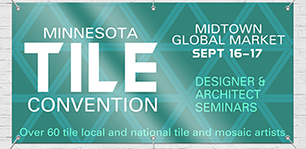How to Design Banners: 6 Tips from a Creative Director
In a world where we're bombarded with advertisements in-person and online, you'll need a distinct sign that would make people stop, look, and read your message. This can seem daunting to a small business owner with little to no experience in design. Thankfully, the process isn't as complicated as one might (over) think. Digital Room's Senior Creative Director, Greg Simmons - who leads the company's visual design, UX, brand, and content – shares some tips on how to make a banner design.
1. Stick to a single clear idea and use concise language.
"Simplicity is key to good signage and anything out in the environment," Greg explains. If your banner has too many details, you'll lose readers who glance at your sign but look away because so much is going on. You're also competing with other displays. Greg emphasizes that we're constantly bombarded with "signs, language, and advertising." Your banner needs to grab the reader's focus and clearly communicate its purpose in a few seconds.
A good example Greg highlights are the wayfinding systems or signs we use to navigate large places like an airport or office building. "These types of signages share the same thing: limited in what they communicate, have one idea, and are clear and concise," he says.
2. Position crucial information on the banner's most visible area.
Greg points out a common mistake among first-time banner designers: the most critical information is found at waist level or by people's feet. If your banner is above eye level, this isn't an issue, but you don't want people to look down when they start reading your signage. Think about how people will see your banner. Will it be low to the ground, displayed below a tree or on a fence, or will it be in a high school or junior high stadium? The most important information should be the first thing they see however you display the banner.
3. Make sure it's easy to read at a distance.
After completing the first draft of your banner design, Greg recommends printing a version of it (or one component of it, like the headline text) and taping it on a wall. Walk back 10 to 30 feet from the displayed printout and see if you can read it from a distance. From there, you'll see if the font size is too big or too small, if the image you placed is too much or too little, or if the banner needs more room to show one clear idea. Use your best judgment to remove unnecessary elements or add any missing parts.
4. Use colors that pop from its surroundings.
Your banner isn't supposed to blend in with its display location. Your signage needs to be the first thing potential customers see. "If you know where the banner is going to be, then part of your sign's color decision should be different than what is around it," Greg explains. If you choose a hue that's similar to the surrounding signs and objects, then passersby will miss your banner.
Other factors play into your banner's color choices. Greg suggests asking yourself the following questions to narrow down or expand your options: How are people seeing the sign? Will they be walking up to it? Is it something they're seeing from afar or will people naturally walk towards its direction?
5. Stay away from illustrative fonts.
A readable font ensures everyone understands your sign in one glance. Many font types and families are available, but Greg warns to "stay away from any font that looks like an illustrator drew or painted it." Some examples he points out are brush stroke type fonts or the ones that have leaves coming out of them. Illustrative fonts are hard to read and could deter your viewer from viewing the rest of your banner.
6. Think about signs that catch your attention.
When stumped for inspiration, we look at the banners of famous brands and copy what they're doing. But Greg advises instead of duplicating them, we must consider their designs and why they work. Be mindful of what draws you closer to the sign on your way to work or the nearby grocery. Notice the parts that make you stop and consider how to incorporate these aspects into your banner design.
Greg cites Nike's advertisements as an example. Their signs usually have three parts: a shoe or a runner, one or two words, and their logo. The simple design draws you in—every time. Based on what you see, how would you apply the most effective elements to your own banner?
Start Customizing a Banner Today
Wondering how to make a banner design for the first time can be intimidating. But your final look boils down to sticking to a single idea, communicating it concisely, and avoiding doing too much. Once you've gathered your thoughts for the banner, you can create one online on eSigns. Get ideas from?our free templates or use the online design tool to explore different possibilities.
About the interviewee, Greg Simmons: Prior to Digital Room, Greg led design and creative at top international design agencies like R/GA, Rosetta, and SapientRazorfish - developing unique and award-winning digital and printed solutions for AT&T, IBM, KitchenAid, Zales, Hickory Farms, The Smithsonian, TimeWarner, and others. His unique perspective on design and communication combines his roots in Swiss design with his deep understanding of identity.

